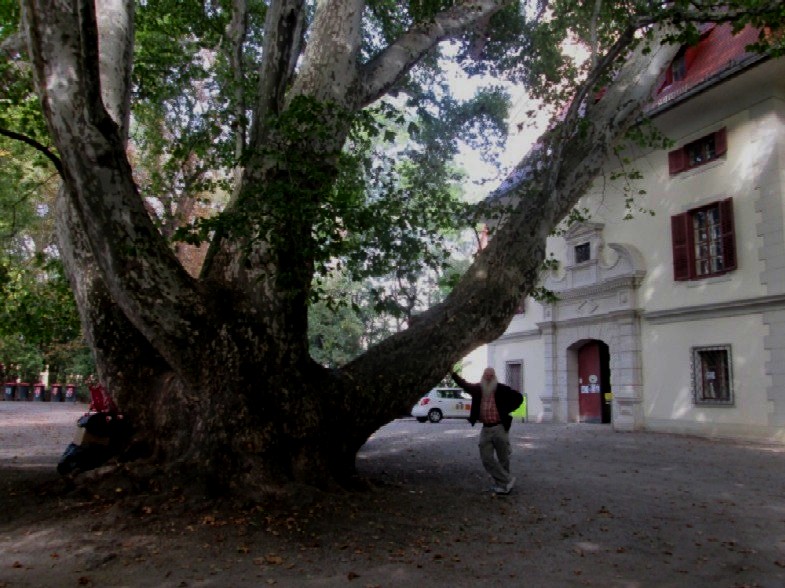|
The
|
||||||||||||||||||||||||||||||||||||||||||||||||||||||||
THE BURGENLAND BUNCH NEWS - No. 260 October 31, 2015, © 2015 by The Burgenland Bunch All rights reserved. Permission to copy excerpts granted if credit is provided. Editor: Thomas Steichen (email: tj.steichen@comcast.net) Archives at: BB Newsletter Index Our 19th Year. The Burgenland Bunch Newsletter is issued monthly online. It was founded by Gerald Berghold (who retired from the BB in the Summer of 2008 and died in August 2008). |
||||||||||||||||||||||||||||||||||||||||||||||||||||||||
Current Status Of The BB: * Members: 2379 * Surname Entries: 7673 * Query Board Entries: 5484 * Staff Members: 17 |
||||||||||||||||||||||||||||||||||||||||||||||||||||||||
This newsletter concerns: 1) THE PRESIDENT'S CORNER 2) HISTORICAL BB NEWSLETTER ARTICLES: - IMMIGRANT LANGUAGE AS A CLUE TO ORIGIN (Gerry Berghold) 3) ETHNIC EVENTS 4) BURGENLAND EMIGRANT OBITUARIES (courtesy of Bob Strauch) |
||||||||||||||||||||||||||||||||||||||||||||||||||||||||
1) THE PRESIDENT'S CORNER (by Tom Steichen)  This
is an abbreviated newsletter, as my month has been busy traveling, having grandkids and other
visitors in the house, and doing fall clean-up in the gardens and yard. Although the gardens are
my wife's project, when it comes to the heavy digging, my old back always gets invited to the
'garden party' ...and she had lots of plants that needed dividing, thinning, discarding or
moving this year! Ouch! Somehow, though, she did not find time to assist me on the working end
of a leaf rake... but I truly did not expect she would! This
is an abbreviated newsletter, as my month has been busy traveling, having grandkids and other
visitors in the house, and doing fall clean-up in the gardens and yard. Although the gardens are
my wife's project, when it comes to the heavy digging, my old back always gets invited to the
'garden party' ...and she had lots of plants that needed dividing, thinning, discarding or
moving this year! Ouch! Somehow, though, she did not find time to assist me on the working end
of a leaf rake... but I truly did not expect she would! As for grandkids, with a 4-year-old and a suddenly very mobile 16-month-old in a house not fully prepared for little ones, we ended their two separate stays feeling like very tired border collies! Needless to say, little research or writing was done while they were here! Likewise, we had friends from North Carolina stay with us for parts of five days, as they stopped overnight with us while traveling up to visit her daughter in Philadelphia, and then stayed two nights for a proper visit on the return trip. It was a good visit but made it difficult to work on a newsletter. As for travels, my wife and I did a trip into the Finger Lakes area of New York, both to enjoy the area (as we had never been there before) and to do a little genealogical exploration into the fate of a great aunt of my wife who had moved from northern Minnesota in 1919 to Spencer, NY (and we learned much about her and her family, so the effort was a great success). We also traveled jointly with another couple on a trip into western Pennsylvania and to its major city of Pittsburgh. Our friends had never been to Pittsburgh and we had barely explored it on the single day my wife and I had previously been there, so it was an opportunity to properly enjoy the city, which we did! Concerning this newsletter, it will consist only of some bits and pieces here in my "Corner" and our standard sections: Historical Newsletter Articles, and the Ethnic Events and Emigrant Obituaries sections. BB Membership Forms Down But Now Fixed: We suffered a short-term problem with our BB automated Membership Forms this past month. Although we do not know the exact start date of the problem, it was between October 9 and October 16, this last date being when we were informed of the problem and when it was fixed. We do know that the forms worked correctly on October 9. If you attempted to register or modify your registered information during this time and you received an "Internal Server Error" message, your form data was not processed; you will need to reenter your data and/or changes. We apologize for the inconvenience. Walt Groller Honored For 70 Years As A Band Leader: 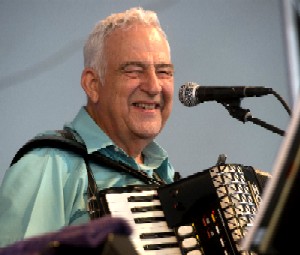 John
Issowits write: On June 13th, 2015, a party/dinner dance was held in Mt. Bethel,
Pennsylvania, as a tribute to Walt Groller’s 70th anniversary as a musician and as the leader of
the Walt Groller Orchestra. My wife, Linda, and I had the pleasure of attending this
function with over 300 guests. Music was provided by Frank Billowitz and the Austrian
Boys Band and, near the end of the evening, we convinced Walt to also play a few songs. It
was a special day for Walt, with wife Marilyn at his side as well as his children Joe, Tom and
Anita, his sister Delores and brother-in-law Dr. Ed Krupa (former band member) and their
families. Walt Groller has always been proud of his heritage and music as a Burgenländer and is
known for his motto of "Bringing people together through music." During the ceremony,
Walt received an acknowledgement from the Austrian Ambassador in Washington, D.C., and numerous
other awards from his Congressman, Charles Dent, the Mayor of Whitehall, Ed Hozza, and Mario
Andretti. Walt and his family have organized a Viennese Ball for 39 years to raise funds
for many charities in Pennsylvania. Walt was proud to announce that, after 39 years, his son Joe
and his wife Ellen will now run the very popular Viennese Ball—which is held each
spring—with the next one being in April 2016 in Pottstown, Pennsylvania. After all the speeches,
Walt took the microphone to thank all the people who were there and who have supported him over
the years. Walt made us all laugh about one of the songs he wrote in 1985, entitled "Popa,
the Old Accordion Man," and said that, 30 years later, he has now become that man. John
Issowits write: On June 13th, 2015, a party/dinner dance was held in Mt. Bethel,
Pennsylvania, as a tribute to Walt Groller’s 70th anniversary as a musician and as the leader of
the Walt Groller Orchestra. My wife, Linda, and I had the pleasure of attending this
function with over 300 guests. Music was provided by Frank Billowitz and the Austrian
Boys Band and, near the end of the evening, we convinced Walt to also play a few songs. It
was a special day for Walt, with wife Marilyn at his side as well as his children Joe, Tom and
Anita, his sister Delores and brother-in-law Dr. Ed Krupa (former band member) and their
families. Walt Groller has always been proud of his heritage and music as a Burgenländer and is
known for his motto of "Bringing people together through music." During the ceremony,
Walt received an acknowledgement from the Austrian Ambassador in Washington, D.C., and numerous
other awards from his Congressman, Charles Dent, the Mayor of Whitehall, Ed Hozza, and Mario
Andretti. Walt and his family have organized a Viennese Ball for 39 years to raise funds
for many charities in Pennsylvania. Walt was proud to announce that, after 39 years, his son Joe
and his wife Ellen will now run the very popular Viennese Ball—which is held each
spring—with the next one being in April 2016 in Pottstown, Pennsylvania. After all the speeches,
Walt took the microphone to thank all the people who were there and who have supported him over
the years. Walt made us all laugh about one of the songs he wrote in 1985, entitled "Popa,
the Old Accordion Man," and said that, 30 years later, he has now become that man.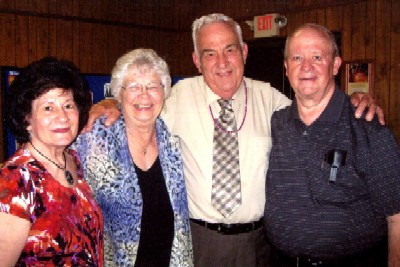 As
I looked back over the 50 years that I have known Walt, he has accomplished so very much in life
and has been honored so many times for helping to keep the Austrian music alive in America. He
has gone to schools in Pennsylvania to perform and to teach the children about their heritage.
Linda and I have been with Walt and Marilyn on a few cruises and the Pocono Mountain
Christmas Weekends and we know how hard they worked to make sure that all of us attending
enjoyed the days we were with them. Over the years, the Walt Groller Orchestra has
recorded at least 24 record albums, cassettes or CD’s. I think he even had 8-track tapes, if you
can remember those. He has had 31 group trips to Austria/Burgenland, Germany, Switzerland and
many other European countries as well as 34 group cruises to Europe, Hawaii, South America and
the Caribbean. Another popular function was the Pocono Mountain Christmas Weekends, which
numbered 27 years. Walt admits putting all these big trips and functions together was a lot of
work and credits his wife Marilyn for all her time and work that always make these a success. In
addition to all of the above, it is hard to count the number of times over the 70 years that the
Walt Groller Orchestra played for dances, weddings and musikfests throughout the
country. As
I looked back over the 50 years that I have known Walt, he has accomplished so very much in life
and has been honored so many times for helping to keep the Austrian music alive in America. He
has gone to schools in Pennsylvania to perform and to teach the children about their heritage.
Linda and I have been with Walt and Marilyn on a few cruises and the Pocono Mountain
Christmas Weekends and we know how hard they worked to make sure that all of us attending
enjoyed the days we were with them. Over the years, the Walt Groller Orchestra has
recorded at least 24 record albums, cassettes or CD’s. I think he even had 8-track tapes, if you
can remember those. He has had 31 group trips to Austria/Burgenland, Germany, Switzerland and
many other European countries as well as 34 group cruises to Europe, Hawaii, South America and
the Caribbean. Another popular function was the Pocono Mountain Christmas Weekends, which
numbered 27 years. Walt admits putting all these big trips and functions together was a lot of
work and credits his wife Marilyn for all her time and work that always make these a success. In
addition to all of the above, it is hard to count the number of times over the 70 years that the
Walt Groller Orchestra played for dances, weddings and musikfests throughout the
country.Over the years, Walt Groller received so many awards; some of them I remember are the 1995 Burgenland Medal of Honor (Ehrenszeichen) that he received from President Wolfgang Dax in a ceremony in the Parliament in Eisenstadt for his contribution to the country of Austria. In 1990, he received the Austrian Medal in Gold from the President of Austria in a Washington, D.C., ceremony and, in the same year, he also received the Austrian Golden Cross for continuing the Austrian culture in America. In 1988, he received a Grammy nomination for one of his albums and, in 1986, Walt was inducted into the Polka Hall of Fame in Chicago. As if he was not busy enough, he had a radio show on Sundays in Pennsylvania for 10 years, then hosted The German Hour on Saturdays for a number of years before moving onto a TV show called Café International on Fridays. This year will also mark his 31st year at the Bethlehem Musikfest. On Sunday Nov. 8th, Walt will be playing during a Mass Celebration at 11:00 a.m. and, at the Agriculture Hall in the Allentown Fairgrounds, along with Slovenian and Polish bands, at an affair called Pennsylvania Polka Fun Day. We were glad to be there to honor Walt Groller for all his achievements over 70 years and to be with all the people who love his music. We all wish Walt many more years of "Happy Music." - John and Linda Issowits Halloween in Familypark Neusiedlersee in St. Margarethen:
Adding Metadata on a PC
Then he sent a picture turning himself into a comparative "G-nome" ("because," he said,
"whenever I find a new huge tree, I feel so small..."): |
||||||||||||||||||||||||||||||||||||||||||||||||||||||||
2) HISTORICAL BB NEWSLETTER ARTICLES Editor: This is part of our series designed to recycle interesting articles from the BB Newsletters of 10 years ago. However, nothing "rang my bell" in the October 2005 edition so I have gone back further in time, to Issue 44 from September 30, 1998. In that edition, Gerry points out that primary language of the immigrant can be a clue to their origins in Burgenland or to their deeper origins in Europe. I expand on one item Gerry mentions, as it is a part of our joint Burgenland history. THE BURGENLAND BUNCH NEWS No. 44 September 30, 1998 IMMIGRANT LANGUAGE AS A CLUE TO ORIGIN (Gerry Berghold) While stuck in the mid-1600's, as far as expanding my own genealogy is concerned, I continue to pursue subjects that may aid the search. Recently I've been reading "In Search of the Indo-Europeans", J. P. Malloy, Thames & Hudson Publisher, 1997. Tracing the origins of each of the Indo-European peoples of Europe and Asia from both Neolithic and Eneolithic periods and using current archaeological and linguistic evidence, it is a fascinating story: a "prehistoric genealogy," as it were. A modern scientific appraisal of what used to be considered the migrations of the descendants of Noah's sons, Shem, Ham and Japheth. A point made by the author suggested this article. Paraphrasing his remarks slightly. "Languages upon the point of extinction are normally carried to the grave by the older members of the community when the younger members have failed to learn it. This process can happen within three generations. An immigrant family in (the United States), may speak exclusively (German) while their children become bilingual. They in turn decide to raise their children exclusively in English. Within three generations grandparent and grandchild can no longer communicate." This applies to our research in two distinct areas. Since we have three major language groupings in the Burgenland (i.e. German, Croatian, and Hungarian, plus some Romany and Yiddish), we must always consider what language our individual immigrant ancestors used in the early days of their emigration. Why waste time looking in exclusively German villages for ancestors who spoke Croatian or Hungarian full time, or vice-versa? If we don't know what language they spoke, we may find some documents or perhaps the US Census may tell us (1910 and 1920 carry this data). We can then look in which villages the particular language was spoken. We can find information in the LDS holdings as LDS microfiche 6001476 "Topographical lexicon of the communities of Hungary compiled officially in 1773." Our area is mostly covered in the section under "Comitatus Castriferrei" (an older name for Vas Megye). Villages are listed under Latin, Hungarian, German and Croatian (Slavonic) names, by parish. Chief religion and principle language is then shown. While many of us know the primary villages of our ancestors, the above may also help in locating others. One could say that this isn't very helpful given that 85% of Burgenländers are German. However even here one can differentiate between those who spoke (speak) Hianzisch and those who did not. The former are probably from the southern half of Burgenland. Likewise there is a group in the Bakony Hills of Hungary (see previous newsletters) who speak something similar. Hianzisch is a softer language, slurred a little like a US southern accent and full of strange words and "o", and "oa" endings. To us, if it looks or sounds like German but differs from what we learn in US schools, it's probably Hianzisch. The second area of relevance involves pre-Burgenland place of origin. Here also, language can play a part. I wouldn't look in Bavaria or Styria for ancestors who spoke Croatian or Hungarian. Even in the Germanic lands there is a possibility that the dialects spoken in Burgenland (like Hianzisch) may point to particular regions in the Germanic or Slavic lands. In other words, narrow the choices. Language within the framework of general family grouping is a clue to origin just like culture, music, food and folktales. Think about it as you search for that elusive village. 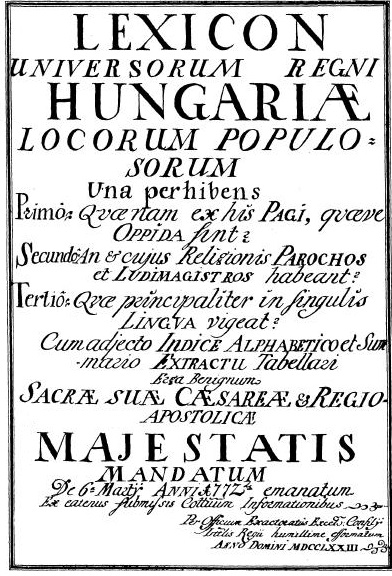 Editorial
Note (current-day): The above mentioned lexicon, "Topographical lexicon of the
communities of Hungary compiled officially in 1773," is actually a 1920 reprinting of the
1773 document "Lexicon Universorum Regni Hungariæ Locorum
Populosorum" as republished by the "Delegation of Peace of Hungary," which was
Hungary's delegation to the 1920 Peace Talks in Paris. (Note: A viewable / searchable pdf
of this lexicon can be found here:
http://hdl.handle.net/2027/njp.32101073850024. Editorial
Note (current-day): The above mentioned lexicon, "Topographical lexicon of the
communities of Hungary compiled officially in 1773," is actually a 1920 reprinting of the
1773 document "Lexicon Universorum Regni Hungariæ Locorum
Populosorum" as republished by the "Delegation of Peace of Hungary," which was
Hungary's delegation to the 1920 Peace Talks in Paris. (Note: A viewable / searchable pdf
of this lexicon can be found here:
http://hdl.handle.net/2027/njp.32101073850024.The major purpose of the Peace Talks was to decide upon the reparations to be paid by the losers of the First World War, and one outcome was the Treaty of Trianon, which redefined Hungary's borders (and also resulted in the formation of Burgenland). It should be noted though, that the delegation sent to the Talks by the Hungarian Government was imprisoned without being admitted to the Peace Talks and the Treaty of Trianon, which declared great losses of territory for Hungary, was declared final without Hungarian input. Not surprisingly, the Hungarian delegation did nor want to accept what they considered an immensely unfair treatment and thus the delegation started to work to prove the historic errors, geographical mistakes and economic absurdities that have been termed crucial to the decisions of the Peace Talks. One document generated for this purpose was the reprinting of the Lexicon, which was intended to show that the lingual boundaries in 1920 Hungary did not differ from those of 150 years before. As was stated in the preface added to the document in 1920, "The [in]tuitions which we can conclude from the Lexicon prove that the Hungarians used their political power in the past to no other purposes with regard to the nationalities living on Hungarian territory but to the spreading of western culture among them." Of course the smaller successor states around Hungary were eager to receive parts of Hungary, thus their delegates tried to claim historic linguistic control of as much territory as possible, or claimed that the Hungarians had forced linguistic changes in the border areas. The Hungarians, of course, wanted to retain control of as much area as possible, especially those areas that they had controlled for over 1000 years—including Burgenland, though most of the argument concerned the far larger areas on her other borders (such as in current-day Slovak Republic, Poland, Ukraine and Romania). Nonetheless, the Lexicon (and other information) was entirely disregarded and the delegation was never allowed to participate in the Peace Talks. The French were especially eager to reward the nations who fought on the French side during the war. Despite the original intention to just weaken the entire Austro-Hungarian Empire, integral parts of Hungary were taken away that had belonged to her for over a 1000 years. According to Charles Danielou, a French politician, the victors really did not want to punish Hungary but rather wanted to reward and satisfy their allying states. And thus we remake our world! |
||||||||||||||||||||||||||||||||||||||||||||||||||||||||
3) ETHNIC EVENTS LEHIGH VALLEY, PA Sunday, November 8: Polka Fun Day at the Allentown Fairgrounds (Agri-Plex). Polka Mass at 11 AM. Music by the Walt Groller Orchestra, The Polka Quads, and John Stevens & Doubleshot. Info: (610) 871-1416. Wednesday, November 11: Deutscher Gemütlichkeit Abend at the Reading Liederkranz. Info: www.readingliederkranz.com Saturday, November 21: Stiftungsfest of the Alpenrose Schuhplattler-Verein at the Lancaster Liederkranz. Info: www.lancasterliederkranz.com NEW BRITAIN, CT Friday, November 7, 7 pm: Heimat Abend. Austrian Donau Club, 545 Arch Street, $3. Music by Joe Rogers and his band. Friday, November 21, 7:30 pm: Heurigan Abend. Austrian Donau Club, 545 Arch Street, $3. Music by Schachtelgebirger Musikanten. NEW HYDE PARK, NY Sunday, November 1, 12:30 pm: Katharina Fest Dinner/Dance. New Hyde Park Inn. Music by the Heimatklänge. Come meet other BB members. For info, call Frank Paukowits (718-776-2716). |
||||||||||||||||||||||||||||||||||||||||||||||||||||||||
4) BURGENLAND EMIGRANT OBITUARIES Emma Legath (née Gober)  Emma
Legath, 80, of Dobbs Ferry died peacefully on October 13, 2015. Emma
Legath, 80, of Dobbs Ferry died peacefully on October 13, 2015.Emma was born in Steinfurt, Burgenland, Austria and came to the United States in 1960. She settled in the Bronx and moved to Dobbs Ferry in 2001. Emma was a chef at Castle Harbor Casino in the Bronx for many years. She was a member of the Brotherhood of the Burgenländer in New York. Surviving is her husband Martin, son Herbert and his wife Barbara, grandchildren Ryan, Richard and Emily. Emma was predeceased by her daughter Heidi in 1988 and her grandson Erik in 2006. The funeral service will be Friday 10:00 am Edwards-Dowdle Funeral Home, 64 Ashford Avenue, Dobbs Ferry. Visiting Thursday 2-4 & 7-9 pm. Memorials to the Cystic Fibrosis Foundation, Westchester Chapter, 200 Mamaroneck Avenue, Ste. 603, White Plains, NY 10601. www.cff.org/westchester Published in the lohud.com on Oct. 14, 2015 Pauline M. Menyhart (née Mersits)  Pauline
M. Menyhart, 94, passed away at 9:25 am Wednesday, October 14, 2015. Pauline was born on
September 19, 1921, in Gross Mutschen, Austria, to Anton and Theresa (Tustich) Mersits. Pauline
M. Menyhart, 94, passed away at 9:25 am Wednesday, October 14, 2015. Pauline was born on
September 19, 1921, in Gross Mutschen, Austria, to Anton and Theresa (Tustich) Mersits. On April 26, 1943, in Holy Cross Church, she married Charles S. Menyhart. He died on November 4, 1981. She was also preceded in death by a daughter, Veronica Menyhart, and a son, Charles Menyhart. Surviving are a daughter, Marie Teresa (Faust) Alvarez of Helena, MT; four sons, Anthony Menyhart of Tecumseh, MI, John (Jody) Menyhart of Miles City, MT, Larry (Eileen) Menyhart of Teaneck, NJ, and Joseph (Karen) Menyhart of South Bend; 13 grandchildren, Dr. Angeles Alvarez, Anne-Marie Alvarez, Alina Alvarez, Aleida Alvarez, Andrea Alvarez, Russell Menyhart, Stephen Meny-hart, Catherine Menyhart, Anna Rapson, Elizabeth Felche, Joseph Menyhart, Kevin Menyhart, and Rosemary Menyhart; four step-grandchildren, Tim Klinedinst, Todd Klinedinst, Daniel Klinedinst, and Rebecca Partipilo; 21 great-grandchildren Connor, Joshua, Lena, Ari, Aleida Ann, Anderson James, Aiden Faustino, Austin Manuel, Elia Margaret, Eva Marie, Margaret, Miles, Lionel, Simone, Nelson, Stella, Clea, Drake, Dylan, Madison, and Marcus; and a brother, Anthony (Helen) Mersits of South Bend. Pauline was an active participant of the former St. Anthony Society Ladies Auxiliary (Hervatske Zene), former DFV German Club Ladies Auxiliary, St. Joseph County Extension Homemakers, Mayflower Extension Homemakers, Serra Club, Forever Learning Institute, Polonaise (Polish Club), and was named 2006 Senior Volunteer of the Year in St. Joseph County. A Mass of Christian Burial will be celebrated at 11:00am Saturday, October 24, 2015 in Little Flower Catholic Church. Friends may call one hour prior to services in the church. Zahoran Funeral Home has been entrusted with arrangements. Cremation has taken place; entombment will occur at Riverview Cemetery. Memorial contributions may be made to Alzheimer's & Dementia Services of Northern Indiana, or Forever Learning Institute, or to the charity of choice. To leave an online condolence, please visit our website at www.zahoran.com, or our facebook page, Zahoran Funeral Home. Published in South Bend Tribune from Oct. 17 to Oct. 23, 2015 Julia Gredlics (née Kondor)  Julia
Gredlics, 91, of Lower Macungie Twp., Pennsylvania, formerly of Bethlehem, died peacefully on
Saturday, October 24, 2015. Julia
Gredlics, 91, of Lower Macungie Twp., Pennsylvania, formerly of Bethlehem, died peacefully on
Saturday, October 24, 2015.She was the wife of the late Joseph Gredlics. Born in Szakonyfalu (Eckersdorf/Sakalovci), Hungary, she was the daughter of the late Stephen and Julia (Csuk) Kondor. Julia worked as a seamstress for the former Fountain Hill Mills and was a parishioner of the former St. Joseph’s Catholic Church, Bethlehem. She loved cooking and baking and spending time with her family. She will be lovingly remembered by her daughter, Julie Hess of Allentown; her son, Joseph Stephen Gredlics and wife, Rebecca of Columbia, MD; her sister, Irene Schrei; nine grandchildren and 37 great-grandchildren. A Funeral Service will be held on Thursday, October 29, 2015 at 1:30 p.m. at Connell Funeral Home, Inc. 245 E. Broad St. Bethlehem, PA 18018 (www.connellfuneral.com). Visitation will be from 11:30 a.m. to 1:30 p.m. in the funeral home. Burial will be at Holy Saviour Cemetery, Bethlehem. Published in the Morning Call on October 27, 2015 |
||||||||||||||||||||||||||||||||||||||||||||||||||||||||
| END OF NEWSLETTER (All good things must end!) |
||||||||||||||||||||||||||||||||||||||||||||||||||||||||
NOTICE (Terms and Conditions): The Burgenland Bunch (BB) was formed and exists to assist Burgenland descendants in their research into their heritage and, toward that end, reserves the right to use any communication you have with us (email, letter, phone conversation, etc.) as part of our information exchange and educational research efforts. • If you do not want your communication to be used for this purpose, indicate that it is "confidential" and we will abide by that request. • Correspondents who communicate with the BB without requesting confidentiality retain their copyright but give a non-exclusive license to the BB allowing us to forward to BB members, publish in our monthly newsletter or on our website, and/or subsequently and permanently archive all or parts of such communications. The Burgenland Bunch homepage (website) can be found at: http://www.the-burgenland-bunch.org Burgenland Bunch Newsletter, copyright © 2015 by The Burgenland Bunch All rights reserved. Permission to copy excerpts granted if credit is provided. |
 News
News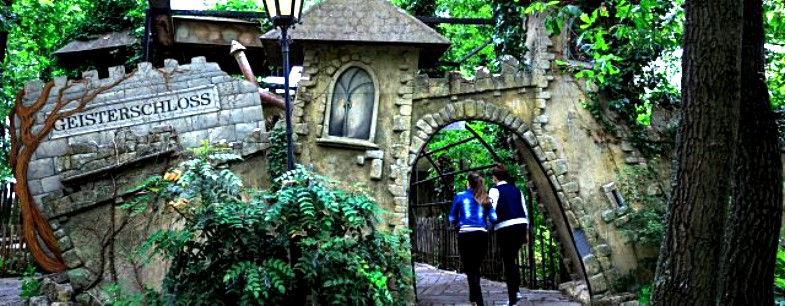
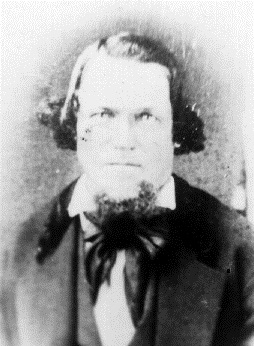 An
early competitor, the calotype process, was developed by William Henry Fox Talbot,
who succeeded in creating stabilized photographic negatives on paper in 1840. Unlike a
daguerreotype, which could only be copied by rephotographing it, a calotype negative
could be used to make a large number of positive prints by simple contact printing. However,
calotypes lacked fine clarity due to the translucent paper negative, though this was seen
then as a positive attribute for portraits. Talbot patented his process, which greatly limited
its use so comparatively few photographs were made in this way (I think I have two among
maybe 50 "old" surviving family photographs; one shown to the right). Nonetheless, Talbot's
underlying process eventually became the basis for modern film photography.
An
early competitor, the calotype process, was developed by William Henry Fox Talbot,
who succeeded in creating stabilized photographic negatives on paper in 1840. Unlike a
daguerreotype, which could only be copied by rephotographing it, a calotype negative
could be used to make a large number of positive prints by simple contact printing. However,
calotypes lacked fine clarity due to the translucent paper negative, though this was seen
then as a positive attribute for portraits. Talbot patented his process, which greatly limited
its use so comparatively few photographs were made in this way (I think I have two among
maybe 50 "old" surviving family photographs; one shown to the right). Nonetheless, Talbot's
underlying process eventually became the basis for modern film photography.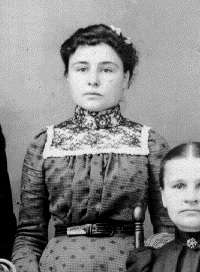 Things
changed in the mid-1850s when tintypes became possible. Compared to the
daguerreotype, tintypes were not only very inexpensive, they were also relatively
easy and quick to make. A photographer could prepare, expose, develop and varnish a tintype
plate and have it ready for the customer in a few minutes. Further, unprotected tintypes,
mounted on just a paper mat, were possible from the beginning. And compared to a calotype,
the images were sharp and clear (I have a few of these too).
Things
changed in the mid-1850s when tintypes became possible. Compared to the
daguerreotype, tintypes were not only very inexpensive, they were also relatively
easy and quick to make. A photographer could prepare, expose, develop and varnish a tintype
plate and have it ready for the customer in a few minutes. Further, unprotected tintypes,
mounted on just a paper mat, were possible from the beginning. And compared to a calotype,
the images were sharp and clear (I have a few of these too). On
a PC in Windows Explorer (the file manager), right-click on the image and select
Properties... you should see a sub-panel appear that looks like the partial example shown to
the right (I chopped off most of the lower part of it). If you want to rename the file, you can
do that in the "General" tab, as shown here. The new name goes in the box (where "pic1870s.jpg"
appears in my example). Be sure not to change the ".jpg" part of the file name (or whatever
filename extension your file has).
On
a PC in Windows Explorer (the file manager), right-click on the image and select
Properties... you should see a sub-panel appear that looks like the partial example shown to
the right (I chopped off most of the lower part of it). If you want to rename the file, you can
do that in the "General" tab, as shown here. The new name goes in the box (where "pic1870s.jpg"
appears in my example). Be sure not to change the ".jpg" part of the file name (or whatever
filename extension your file has).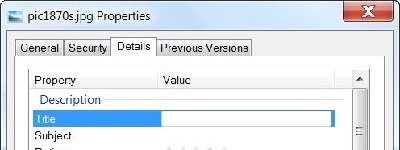 To
edit the metadata, you need to click the "Details" tab. Again, I've only shown the top
part of the panel... what you should see is the named "Property" on the left with its
corresponding "Value" on the right (most values will be blank). Clicking in the "Value" side of
a "Property" will highlight the Property name and allow you to type whatever you want into the
"Value" field. These new entries will remain with the picture, even if you send it to someone.
To
edit the metadata, you need to click the "Details" tab. Again, I've only shown the top
part of the panel... what you should see is the named "Property" on the left with its
corresponding "Value" on the right (most values will be blank). Clicking in the "Value" side of
a "Property" will highlight the Property name and allow you to type whatever you want into the
"Value" field. These new entries will remain with the picture, even if you send it to someone. Update
for book "The Burgenländer Emigration to America": Here is this month's update on
purchases of the English issue of the 3rd edition of Dr. Walter Dujmovits' book "Die
Amerika-Wanderung Der Burgenländer."
Update
for book "The Burgenländer Emigration to America": Here is this month's update on
purchases of the English issue of the 3rd edition of Dr. Walter Dujmovits' book "Die
Amerika-Wanderung Der Burgenländer."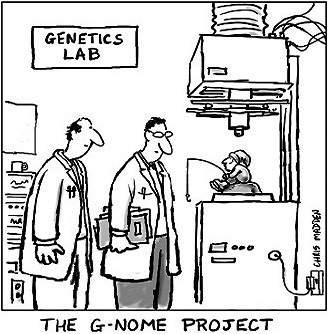 (Last
Month's) Cartoon of the Month:
(Last
Month's) Cartoon of the Month: